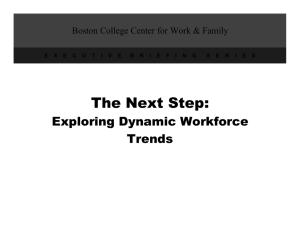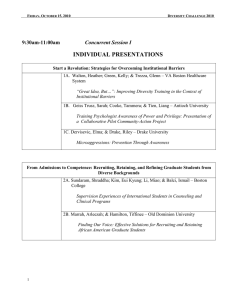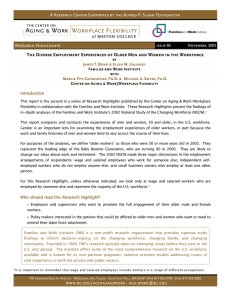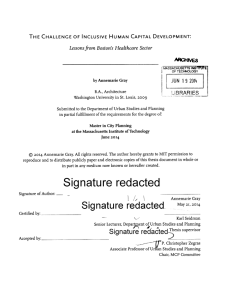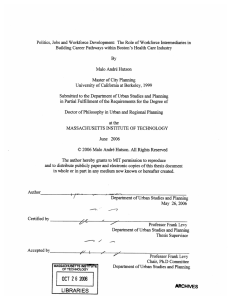Exploring Diversity: Race and Culture in the Inclusive Workplace
advertisement
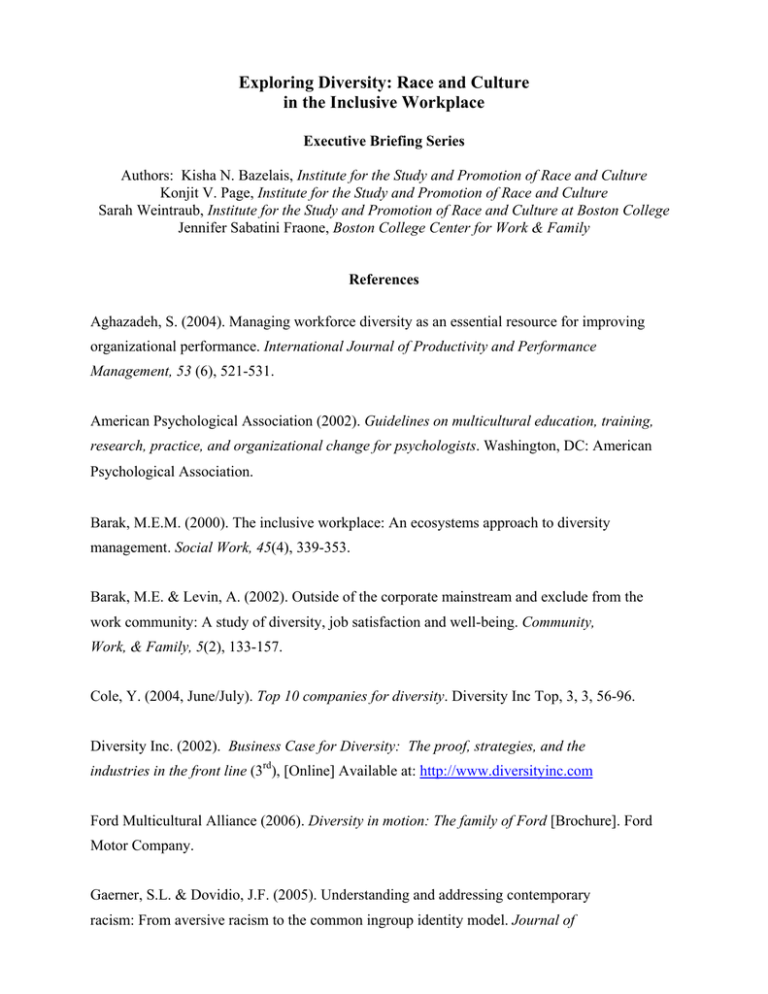
Exploring Diversity: Race and Culture in the Inclusive Workplace Executive Briefing Series Authors: Kisha N. Bazelais, Institute for the Study and Promotion of Race and Culture Konjit V. Page, Institute for the Study and Promotion of Race and Culture Sarah Weintraub, Institute for the Study and Promotion of Race and Culture at Boston College Jennifer Sabatini Fraone, Boston College Center for Work & Family References Aghazadeh, S. (2004). Managing workforce diversity as an essential resource for improving organizational performance. International Journal of Productivity and Performance Management, 53 (6), 521-531. American Psychological Association (2002). Guidelines on multicultural education, training, research, practice, and organizational change for psychologists. Washington, DC: American Psychological Association. Barak, M.E.M. (2000). The inclusive workplace: An ecosystems approach to diversity management. Social Work, 45(4), 339-353. Barak, M.E. & Levin, A. (2002). Outside of the corporate mainstream and exclude from the work community: A study of diversity, job satisfaction and well-being. Community, Work, & Family, 5(2), 133-157. Cole, Y. (2004, June/July). Top 10 companies for diversity. Diversity Inc Top, 3, 3, 56-96. Diversity Inc. (2002). Business Case for Diversity: The proof, strategies, and the industries in the front line (3rd), [Online] Available at: http://www.diversityinc.com Ford Multicultural Alliance (2006). Diversity in motion: The family of Ford [Brochure]. Ford Motor Company. Gaerner, S.L. & Dovidio, J.F. (2005). Understanding and addressing contemporary racism: From aversive racism to the common ingroup identity model. Journal of Social Issues, 61(3), 615-639. Hart, M. A. (1997). Managing diversity for sustained competitiveness. New York: The Conference Board. Hartenian, L.S. & Gudmundson, D.E. (2000). Cultural diversity in small business: Implication for firm performance. Journal of Developmental Entrepreneurship, 5, 209-219. Heet, J.A. (2003). Beyond workforce 2020: The coming (and present) international market for labour. Hudson Institute, Indianapolis, IN. [Online] Available at: http://www.hudson.org/files/publications/workforce_international_mkt_labor.pdf Hewlett, S.A., Luce, C.B. & West, C. (2005). Leadership in your midst: Tapping the hidden talents of minority executives. Harvard Business Review (On Point), 2211, 74-82. Hyun, J. (2005). Breaking the bamboo ceiling: Career strategies for Asians. New York: HarperCollins, Inc. Kelly, P.J. (2005, November). As America becomes more diverse: The impact of state higher education inequality. National Center for Higher Education Management Systems: Boulder, CO. Krupka, K. (2006) Partner Profile Series: Employee Resource Groups, published by the Boston College Center for Work & Family Lan, P. (2002). Subcontracting filial piety: Elder care in ethnic Chinese immigrant families in California. Journal of Family Issues, 23, 812-835. Mac Rae, H. (1992). Fictive kin as a component of the social networks of older people. Research on Aging, 14(2), 226-247. McCuiston, V.E., Wooldridge, B.R., & Pierce, C.K. (2004). Leading the diverse workforce: Profit, prospects, and progress. The Leadership & Organization Development Journal, 25 (1), 73-92. Miller, Frederick A. and Katz, Judith H. 2002. The Inclusion Breakthrough: Unleashing the Real Power of Diversity. San Francisco: Berrett-Koehler Publishers NAS Recruitment Communications (2007) Diversity Recruitment: A vital strategic resource for competitive advantage [Online] Available at: http://www.nasrecruitment.com/MicroSites/Diversity/articles/featureD16.html National Urban League. (2004, June). Diversity practices that work: The American worker speaks. New York: Rich, R. (2005). Organizational inclusion. Paper presented at the Spring Strategic Human Resources, Leadership, and Organizational Effectiveness Group Luncheon at Cornell University, Ithaca, NY. Sacco, J.M. & Schmitt, N.W. (2003). The relationship between demographic diversity and profitability: A longitudinal study. Paper presented at the 18th Annual Conference of the Society for Industrial and Organizational Psychology, Orlando, Fl. Sanchez, J.L., & Brock, P. (1996). Outcomes of perceived discrimination among Hispanic employees: Is diversity management a luxury or a necessity? Academy of Management Journal. 39(3), 704-719. Saunders, N.C. (2006, November). Employment outlook 2004-2014: A Summary of BLS projections to 2014. Monthly Labor Review, 3-9. Sparks, E. (2006). Creating a racially and culturally welcoming environment. Paper presented at the first annual Summer Program on Race and Culture of the Institute for the Study and Promotion of Race and Culture at Boston College, Chestnut Hill, MA. Storke, D., Wilson, F., Bowles, A.W., Sproull, J. & Vena, J. (2005). The new workforce reality: Insight for today, implications for tomorrow. Report from a Collaborative Study with Simmons School of Management and Bright Horizons Family Solutions. Boston, MA. [Online] Available at: www.simmons.edu/som/docs/centers/workforce_reality_study.pdf Sue, D.W. (1998). In search of cultural competence in psychotherapy and counseling. American Psychologist, 53, 440-448. Swanberg, J.E., Pitt-Catsouphes, M., & Drescher-Burke, K. (2005). A Question of Justice: Disparities in Employees' Access to Flexible Schedule Arrangements. Journal of Family Issues, 26(6), 866-895. Triandis, H.C. (1995). A theoretical framework for the study of diversity. In M.M Chemers, S. Oskamp & M.A. Constanzo (Eds), Diversity in Organizations: New Perspectives for a Changing Workplace. Thousand Oaks, CA: Sage. Vallario, Cynthia Waller (2006) Creating an environment for global diversity: global diversity in the workplace is not just a human resources issue, but a business strategy that embraces many elements. Financial Executive April 1, 2006 Visconti, L. 2007. Diversity Inc. 2007 Top50 Companies for Diversity. Diversity Inc. 6(6): 62. Watts, R. & Carter, R. (1991). Psychology aspects of racism in organization. Group and Organizational Studies, 16, 328-344. Wheeler, M.L. (2001). The diversity executive: Tasks, competencies, and strategies for effective leadership. New York, NY: The Conference Board. White, R.D. (1999). Managing the diverse organization: The imperative for a new multicultural paradigm. [Online] Available at www.pamij.com/99_4_4_white.mtm. Williams, K.Y., O’Reilly, C.A., & Barsade, S. (1998). Group demography and innovation: Does diversity help? In Gruenfeld, D. H (Ed), Composition: Research on managing groups and teams, Vol. 1. (pp. 183-207). US: Elsevier Science/JAI Press. Workplace Diversity Network (2000, January). Summary report from the 1998 Netter Seminar: Building the framework for organizational inclusion. The Network Newsletter, 7(2). [Online] Available at: http://www.ilr.cornell.edu/extension/wdn/pdf/vol6_no2.pdf






